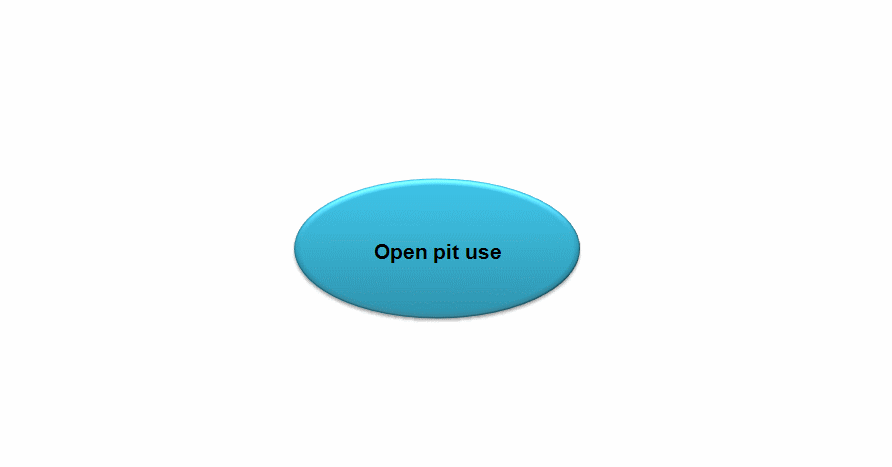Abstract
Content
- 1. Work urgency
- 2. Purpose and objectives of research
- 3. Studies review
- 4. Uses of lands, damaged in a result of mining
- Conclusion
- List of references
1. Work urgency
Mining and processing enterprises tend to occupy large territories and have fairly large mining allotments in use. Mining process is carried out by open, underground and combined methods. With an open process the large areas are occupied by open pits and dumps. As a result of underground mining the rock dumps are formed at the daylight surface. As mining activities have been finished, the areas of open pits and dumps are not used and are not drawn into economic circulation.
Land value calculation is connected with the state of land. Harmful effects, cosed by mining operations, influence the value of land. Traditional methodological approaches for the land estimate unreasonably consider harmful factors (deformation, gaps), which are formed as a result of anthropogenic activities. Thus, the study and analysis of these factors are the relative task.
2. Purpose and objectives of research
Purpose: to study and analyze the factors, that affect the estimate of lands, which have been damaged as a result of mining.
The idea of research is to determine the mining factors influence on the estimate of lands.
In order to achieve the purpose of research the objectives are considered as follows:
- analysis of the factors, that affect the state of lands in underground and open mining areas of the agricultural territories and the lands of residential and public purposes;
- analysis of existing methodological approaches considered for accounting of harmful factors influence;
- formation of the rationale for parameters, that take into account the harmful impact of anthropogenic activity within the process of the mineral resources mining, for the assessment of land.
Object of research – land areas damaged in a result of mining.
Subject of research – estimation of harmful factors impact on the monetary valuation of lands.
3. Studies review
Analyzing the earlier works, we can state that the issue of estimate of lands, damaged in a result of mining operations, is poorly studied. However, the studies of such scientists as: Yu. Gavrylenko, A. Ageev’s, D. Kuznetsova’s, E. Vinichenko, V. Fedchuk, M. Malanchuk, Zh. Adigamova, Ya. Gubar, A. Vovk, V. Rassadin, R. Rudyi, V. Kerker, G. Tkachuk, I. Kapustenko, L. Kazachenko, O. Tributs, should be set off.
In Yu. Gavrylenko and A. Ageev’s work General approach to the assessment of real estate, effected by underground mining
the impact of shifts, coursed by underground mining activity on value of property, located in anthropogenic soils is studied. Within such research a structural logical scheme of special expertise for an objective accounting of underground mining impact on the value of property is suggested, general approach to the assessment of such real estate was offered as well [1].
In D. Kuznetsova’s work Accounting of underground mining impact during normative estimate of land: state and challenges
the issue of underground mining effect on the value of lands in settlements with a direct impact of mining on the building is regarded. On the author’s opinion, land value decline, due to the underground mining influence, depends on the nature of possible shift, deformation of the land surface and type of building. It is suggested to consider the impact of underground mining on the normative value as additional costs [2].
In Yu. Gavrylenko and D. Kuznetsova’s research work Normative monetary estimate of residential areas of the coal lands
the features of mining harmful impact on the real estate and ways of accounting such impact within a normative monetary estimate of lands are studied. General algorithm of land value determination, considering the mining influence, is suggested. Different possible approaches of harmful impact accounting at different stages of normative monetary estimate are analyzed [3].
Yu. Gavrylenko and D. Kuznetsova in their study Accounting of market behavior during the valuation of lands of residential construction, effected by mining activity
search the features of decline of real estate as a result of market resistance (stigma). Factors, which influence the relation of participants of the market of real estate, located in the mining subsidence area, are explored. Opinions of potential buyers to the real estate, affected by underground mining are analyzed [4].
The article E. Vinichenko and V. Fedchuk Problems of introduction of mining disturbed lands into the economic turnover: estimation of reclamation efficiency, new approaches
provides a brief historical sketch of scientific and practical cooperation of DonNIGRI
with mining enterprises of former USSR and Ukraine. There are described some methodological peculiarities of the choice and application of reclamation methods. There are also determined the legal and practical difficulties in implementation of land reclamation, which nowadays appear before different specialists: surveyors, mining engineers, biologists, geologists and agronomists. As a head organization in it’s branch, DonNIGRI
offers the progressive new approaches to decision‑making and designing of various types of reclamation and economic usage of recovered lands, on the basis of actual needs of the community (population of cities and districts), and environmental, economic, architectural and social efficiency [5].
The main aim of M.Malanchuk’s research Improved methods of calculating monetary value of damaged lands
is an improved monetary estimate of damaged lands with different functional purposes. Due to such aim, an approach of the monetary land value calculation, considering the level of it’s anthropogenic lesion, is suggested. The lands, which were agricultural at first, the industrial areas later and the territories of different functional purposes today, are the object of M. Malanchuk’s work. Within such case the author raises the question of correct choice of land estimate method [6].
O. Tributs had performed a research work Cadastral valuation of residential lands in settlements considering the impact of splits
. The main aim of this work was an increased objectivity of the cadastral valuation results and more effective management of the urban areas, basing on an adjustment of existing cadastral valuation method, considered for the residential lands, but with respect to splits. In order to increase the objectivity of cadastral valuation calculation of urban residential lands, within the cadastral valuation methodology the impact of splits is suggested to be considered through the introduction of the integral correction indexes to the specific cadastral valuation coefficients [7].
V. Kerker, R. Rudyi, G. Tkachuk have published a scientific article Determining of the land exposition to account it’s environmental performance and cost
. Within this work an account of land surface exposition during an expert monetary valuation of lands is suggested. For the further index range differentiation and extension, responding for the account of land exposition, during the normative and expert monetary valuation, the methodology of slope and bedding angles calculating, based on DTM data (Krivopillya, Verkhovetskyi region), is performed as well [8].
In Zh. Adigamova’s work An improvement of economic valuation of industrial lands, considering it’s environmental component
a mechanism of valuation of industrial land with respect to it’s environmental component is suggested. It is expected, that such assessment is carried out on the basis of the cost of land parcel, which is in a current use and amount of income from additional use with taking in account possible damage to the environment. Land estimate with a consideration of environmental component is a considerable point in a real land cost calculation process. An environmental component is a complex of such aspects as [9]:
- direct
additional
use value of resources; - indirect practical use value of ecosystem services;
- direct and indirect ecological damage.
In Zh. Adigamova’s work on the base of income approach a possibility of including of the environmental component to the land estimate, regarding to the agricultural areas, mineral deposits and other lands, was considered [9].
L. Каzachenkо in her work Tool maintenance of the estimation of lands (on an example of the polluted territories Forest steppe zone of the Kharkov area)
has suggested land estimate approach, including additional indexes, which reflect the degree of heavy metal pollution of soils. On the base of the sketch maps, which were created by potential and factorial analyses of variance methods, in a respect to regression and factorial analyses results, a proportionality coefficient (Kpc) of land cost, depending on degree of pollution (σ), was determined [10]. It was also suggested to include pollution indexes in a land cost calculation and use during the definition of land tax. Land tax of the polluted areas must be less, according to pollution coefficient. Thus, it was suggested to make the adjustments in land cost calculation, taking into account a pollution degree. During the study the dependence between soil pollution of industrial emissions and productivity and quality of crops was determined. The obtained calculations were suggested to be used within an expert monetary estimate of agricultural lands with an anthropogenic load.
4. Uses of lands, damaged in a result of mining
Despite the fact, that the anthropogenic factors of mining and processing activity are considerable and make harmful impact to the state of land, they practically are not taken into account in determination of it’s future use.
The way of land use, after the mining activity was finished, must be chosen according to the next principles:
- to be physically possible, i. e. to match the resource potential;
- to be legally allowable, i. e. term and form of suggested use should not be under any existing or potential legal restrictions;
- to be financially secured, i. e. the use should provide an income, equal or greater than operation expenses, the sum of financial liability and capital input.
- to be as efficient as possible, i. e. to have the greatest productivity among the hole variants of use, the probability of which is confirmed by market.
According to definition, the use, which maximizes the property value with an appropriate long‑term return rate and risk, is the most efficient variant of use.
On the pictures 1–3 the possible use options for the areas of open pits and dumps after the mining processes, are presented.

Picture 1 – Open pit use
(animation: 6 frames, 5 cycles of repetition, 63.2 Kb)

Picture 2 – Terricone use (renovation)
(animation: 8 frames, 5 cycles of repetition, 34.3 Kb)

Picture 3 – Terricone use (recultivation)
(animation: 4 frames, 5 cycles of repetition, 41.5 Kb)
As mining was finished, in order to use the territories as farmland, in the open pit area a recultivation is likely to be carried out. When a recultivation was made, as far as the taken out fertile soils get closer to the groundwater, providing the crops, the productivity increases [11].
A recultivation with the help of afforestation is possible in cases, when an agricultural or some other use of open pit area brings some certain difficulties, e.g. poor quality of soil, distant location from settlements, unsatisfactory microclimate for growing the crops, etc. [11].
Except the agricultural or forestry recultivation, the excavation places can be used in other ways – as playgrounds, camping areas or resorts [11].
During the waste landfill arrangement, the information about the subterranean waters state in open pit location area, must be analyzed. The distance from the foundation of coffin to the first water‑bearing stratum must be at least 2 m. The most important data is the information about the bedding level of the first water‑bearing stratum, the running direction, resurgence and mineral composition. It is connected with such fact, that during the waste storage process the risk of environmental pollution arises [12].
There are two ways of rock dump use: the first – to leave dead terricones, which are not dangerous for population and look for their new use (renovation); the second – recultivation.
It is much more prospective to use the burning terricones, located at the long distance from heat consumers, when it is possible to locate the heat consumers closer or to convert heating energy into the electrical power. The most effective variation of burning terricones use is electrical power and chemical products generation [13].
Terricones can be used as such high stand for wind‑power plant within the city boundary. The wind situation in Donetsk region for the generation of renewable natural resources is highly benevolent. There are hundreds of dead terricones, height from 40 to 130 m. at the constant winds of 5–6 m. per second speed in Donbass cities. If along the terricone perimeter 10 or even more (according to dump height) wind‑power units, connected in a system, are erected, they are able to provide tens of thousands of people, residents of one big Donetsk district with electricity [14].
Solar energy proceeds can be an additional budget receipt in terms of solar panels placing. Openness of the area is comfortable for solar modules placing and provides with necessary daylight. Furthermore, it greatly reduces the risk of terricone burning, because in such way it is protected from light. The rock filling methodology has been used in many coal‑mining countries. Nevertheless, in Soviet Union countries and in Ukraine later it was not widely used [14].
Purposely, to extract the rear earth products or materials for associated products manufacturing, some terricones can be processed again. Thus, in France and Poland the bauxites aluminum technology is well developed and widely used (bauxites – the rock with 26–28 % alumina content). In Donbass terricones solid the alumina content reaches 21,7 % and in dumps of coal‑cleaning plants – 20,2 %. Thus, terricone solids and dumps of coal‑cleaning plants can be used to produce alumina, necessary for aluminum smelting [14].
In the middle of the previous century on the plant Stalinugol’
the project of building materials plant has been working out, where bricks would be produced basically from shale. However, out of every 20 searched terricones in Donbass only 5–6 can provide the raw material for bricks. Moreover, compo boards, slabs, wainscots, stair flights, elevator shafts, etc. can be produced from rock materials [15].
Conclusion
- Traditional methodological approach of valuation of lands, affected by mining activity is to be adjusted.
- In reviewed studies for the land estimation the proportionality coefficient of land cost and pollution degree or relief state is suggested to be used.
- Renovation or recultivation requires significant capital investment, but not all of them are able to allow the efficient use of damaged lands and to cover the expenses.
- The choice of damaged lands useway must be carried out within projecting of the complete plan of lands development.
List of references
- Ю. М. Гавриленко, А. М. Агеєв. Загальний підхід до оцінки нерухомості, яка піддана до впливу підземних гірничих робіт // Наукові праці Донецького національного технічного університету, серія гірничо‑геологічна, вип. 62, Донецьк, ДонНТУ, 2003. – с. 149–155.
- Д. С. Кузнецова. Врахування впливу підземних гірничих робіт при нормативній оцінці землі: стан и проблеми. – [Електронний ресурс]. – Режим доступу: http://ena.lp.edu.ua.
- Ю. М. Гавриленко, Д. С. Кузнєцова. Нормативна грошова оцінка земель населених пунктів на вугленосних територіях // Наукові праці Донецького національного технічного університету, серія гірничо‑геологічна, вип. 9 (143), Донецьк, ДонНТУ, 2009. – с. 77–85.
- Ю. М. Гавриленко, Д. С. Кузнєцова. Облік реакції ринку при оцінці землі під житловою забудовою, схильною до впливу гірничих робіт // Наукові праці УкрНДМІ НАН України, вип. 3, Донецьк, УкрНДМІ НАН України, 2008. – с. 171–184.
- Є. В. Виниченко, В. С. Федчук. Проблеми залучення порушених гірничими роботами земель в господарський оборот: оцінка ефективності рекультивації, нові підходи // Гірничий журнал: наук. журнал, випуск № 5 (12). Видавничий дім
Руда і метали
. – М., 2013. – с. 46–50. - М. Маланчук. Удосконалення методики розрахунку нормативної грошової оцінки порушених земель // Сучасні досягнення геодезичної науки та виробництва: наук. зб., випуск 2 (24). – Національний університет
Львівська політехніка
, 2012. - О. А. Трібуц. Кадастрова оцінка земель житлової забудови населених пунктів з урахуванням впливу розломів: автореферат дис. – Санкт‑Петербург: електронне видання, 2012.
- В. Б. Керкер, Р. М. Рудий, Г. І. Ткачук. Визначення експозиції земельних ділянок для врахування їх екологічних характеристик і вартості // Вісник
Львівська політехніка
: наук. зб., випуск 75. – Національний університетЛьвівська політехніка
, 2011. - Ж. А. Адігамова. Удосконалення економічної оцінки земель промислових регіонів з урахуванням екологічної складової: автореферат дис. – Москва: електронне видання, 2013.
- Л. М. Казаченко. Інструментальне забезпечення оцінки земель (на прикладі забруднених територій Лісостепової зони Харківської області): дис. канд. техн. наук: 05.24.04 // Національний університет
Львівська політехніка
. – Л., 2005. - Рекультивація та облаштування порушених земель: Підручники та навчальні посібники для студентів ВНЗ // В. І. Сметанін. – М., Колос, 2000. – 96 с.
- С. П. Олійник, І. А. Соломін, С. Є. Харитонов. Організація полігонів захоронення твердих побутових та будівельних відходів на основі відпрацьованих кар’єрів // Промислове та цивільне будівництво: Щомісячний наук.‑техн. і вироб. журнал. – М., 2007. – № 10 (12).
- Є. О. Вороб’йов. Перспективи використання породних териконів / Е. А. Вороб’йов, В. В. Лихачова, Е. А. Сухарь, В. В. Чіглінцева // Вісті автомобільно‑дорожнього інституту: науково‑виробничий збірник / ДВНЗ
ДонНТУ
АДІ. – Горлівка, 2011. – № 1(12). – С. 195–200. - М. Д. Аптекар. Можливість застосування світового досвіду в переробці породи відвалів вугледобувної промисловості у вугільних регіонах Донбасу / М. Д. Аптекар, Н. Г. Матвєєва // Зб. матеріалів Міжнародної науково‑практичної конференції
Економічні та соціальні проблеми вугільних регіонів СНД
. – Краснодон: Краснодонський факультет інженерії та менеджменту Східноукраїнського національного університету ім. В. Даля, 2007. - Л. А. Івченко, Е. М. Лебезова. Про можливість використання териконів з метою підвищення туристичної привабливості Донецького регіону // Вісник Донецького інституту туристичного бізнесу: наук. зб. / ПВНЗ
Донецький інститут туристичного бізнесу
. – Донецьк, 2012. – С. 186–192.
